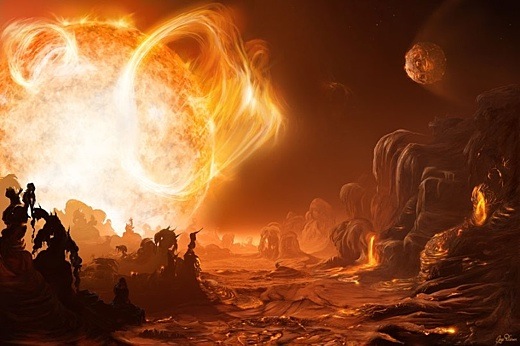By Arius Hopman on 11 May 2012 in Island Breath -
(http://islandbreath.blogspot.com/2012/05/global-thermostat.html)

Image above: Rendering of a hot planet by Inga Nielsen. From (http://www.astronomind.com/faces-of-exoplanets).
On the first day of physics lab, the high school
teacher may set up a classic experiment: fill a beaker with water, add
ice and put a Bunsen burner under it. Measure the temperature of the
water as the ice melts. Huh! Stays the same, just above 32 degrees F.
The melting ice acts as a thermostat to the water. The global situation
is similar. Our melting ice caps and glaciers are helping to keep the
global temperature in check. When they melt, we can expect temperatures
to rise faster.
Our global house is burning while the
scientists are measuring the temperature. Essentially nothing is done
about the fire. We must take individual responsibility.
Another major thermostat is ocean water.
Water has high thermal mass, meaning it takes a lot of heat to warm it
up. As temperatures rise, the ocean becomes a major “heat sink” that
balances global temperatures. Deep space is also a constant heat sink.
Evaporation and clouds/rain are a complex cycle that may also act as a
thermostat. The phase change from ice to water, the heat sink of the
ocean, clouds/rain and deep space are the main thermostats that buffer
the overheating of the planet. We are now rapidly burning through our
terrestrial buffers, ice and water.
But we are literally playing with fire,
because just below the surface of the rapidly melting permafrost layer
and on the ocean floor –- which remains at 3-5 degrees C as long as
there is enough surface ice to melt and release heavy ice water that
sinks—there lurks a powerful genie that, if let out of the bottle, could
send temperatures sky-rocketing in a chain reaction: trillions of tons
of methane. These deposits of methane remain a slushy liquid when kept
close to freezing temperatures, but become a gas as temperatures rise
(another phase change). This potential is called the methane time bomb.
Whether methane burns off or escapes into
the atmosphere, it contributes to global warming, which in turn would
release more methane in a vicious cycle. In the atmosphere, methane
contributes 20 times more warming capacity than does CO2.
We consider ourselves the most intelligent
animal on earth. Will we be intelligent and responsible enough to curb
our energy addiction in time? Or will we set off the methane time bomb?
There is another, chemical, thermostat at
work: atmospheric CO2 is being absorbed/sequestered by the ocean, where
it turns into carbonic acid: fizzy soda water. Already, the ocean has
become 30% more acidic since the industrial revolution. Relieving the
atmosphere of CO2 slows global warming, but what about the acidity in
the ocean? It combines with any CaCO3, calcium it can find, including
shells of countless species, lime in the water, limestone and lime mud.
Atmospheric CO2 also makes the rain acidic,
which likewise combines with calcium, making it more difficult for land
animals to find enough calcium to make bone. Another classic lab test: a
drop of acid on a rock will reveal if the rock contains calcium
carbonate. The reaction neutralizes the acid and CO2 escapes into the
atmosphere. On a global scale, this contribution of CO2 could be
significant, adding to the vicious cycle.
The price we pay for our energy addiction
is heating the atmosphere, melting our global ice, warming and
acidifying oceans and drawing down our global calcium carbonate
reserves. This results in mass extinctions and the likely end of
civilization as we know it.
This is not just hypothesis: it has
happened before! Fifty five million years ago there was a sudden release
of carbon/methane that caused global temperatures to rise about 6
degrees C. Temperatures on the ocean floor rose to 10-12 degrees C
(implicated for releasing the methane) and both poles had tropical
weather. Geologists call it the Paleocene/Eocene Thermal Maximum (PETM:
see the Nov 2011 issue of National geographic). The PETM resulted in
mass extinctions, dwarfed animals (Ca deficiency) and a burst of newly
adapted species.
We may be less lucky, since we have already
initiated an extinction cycle, have depleted 80% of large fish species
stocks and decimated large land animal populations. Also our temperature
rise is exponentially faster than the geologic one 55 mm years ago. We
have been burning our bridges.
A PETM event could happen within this
century if we don’t sober up. The only way to avoid it is to take
individual responsibility to break free from the addictive, exploitative
unsustainable consumption pattern we call “civilization”.
No comments :
Post a Comment